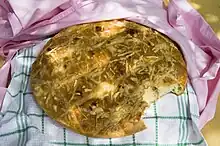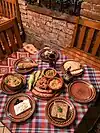 Pogača stuffed with lor cheese and dill | |
| Alternative names | Pogacha |
|---|---|
| Type | Bread |
| Main ingredients | White flour or whole-wheat flour, usually yeast, Egg, Butter |
| Variations | White cheese filling, sucuk, pastirma, ground beef, potato, olive |
| 196kcal per 45 gr [1] kcal | |
Pogača (Turkish: poğaça) is a type of bread baked in the ashes of the fireplace, and later in modern ovens. Found in the cuisines of the Balkans and Hungary it can be leavened or unleavened, though the latter is considered more challenging to make. It is generally made from wheat flour, but barley and sometimes rye may be added. It can be stuffed with potatoes, ground beef, olive, or cheese, and have grains and herbs like sesame, black nigella seed, or dried dill in the dough or sprinkled on top.
Terminology

The word derives ultimately from the Latin panis focacius, i.e. bread (panis) baked on the hearth or fireplace (focus), via the Byzantine Greek πογάτσα (pogátsa), thence entering the South Slavic languages as pogača / погача.
A variant is known as pogačice (diminutive form), a type of puff pastry eaten in Bosnia and Herzegovina, Bulgaria, Croatia, Kosovo, Montenegro, North Macedonia, Serbia, Slovenia, and Turkey (where it is called poğaça) with variations like karaköy. It is called pogatschen in Austria, and pagáče in Slovakia. It is known by similar names in other languages: pogácsa (Hungarian), pogace (Romanian), Greek: μπουγάτσα 'bughátsa', Bulgarian, Macedonian and Serbian Cyrillic: погача, Albanian: pogaçe.

Slovenian pogača is a regional dish from White Carniola and Prlekija that is known locally under various names such as "belokranjska pogača", "ocvirkovca", "gerpa", "oprešak" and "postržjača". Rather than a stuffed savoury pastry, this dish is a type of traditional flatbread that is typically topped with ocvirki.
The pastry

Different localities make slightly different varieties of pogača, and thus there is a wide variety of textures and flavors. Some may be just an inch in diameter; others are much larger. Others have a crumbly scone-like consistency inside, while others are more tender like a fresh dinner roll or croissant.[2]
Many different ingredients can be used either in the dough, sprinkled on top before baking, or both: medium-firm fresh cheeses, aged dry hard cheese(s), pork crackling (tepertő), cabbage, black pepper, hot or sweet paprika, garlic, red onion, caraway seeds, sesame seeds, sunflower seeds or poppy seeds.
In Turkish cuisine, poğaça can be filled with beyaz peynir (white cheese), or other fillings like black olives, potatoes, onions or ground beef.[3]
See also
References
- ↑ "Poğaça". Retrieved 3 January 2016.
- ↑ "English Scones Online". Wednesday, 27 October 2021
- ↑ "Flower Poğaça Rolls". King Arthur Baking.

